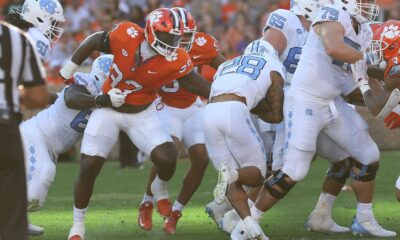
Elite Programs For 2015
The word “elite” has been often used but largely undefined and I set out to try and define it. I’m going to present my definition here for an Elite Program, the things I’ve learned about what creates the perception of eliteness, and some of the benefits of being an Elite Program.
This is basically a part 2 that builds off of my previous post about Elite Teams. If you haven’t read that, you should read it first to understand this post. The word “elite” has been often used but largely undefined and I set out to try and define it. I’m going to present my definition here for an Elite Program, the things I’ve learned about what creates the perception of eliteness, and some of the benefits of being an Elite Program. Some of this will be a refresher from my post on Elite Programs last July. My belief is that Clemson is not an Elite Program but I think we should be, and that we are close. My goal here, as always, is to present the information and let you make up your mind.
College football at the highest level is a perception sport. There is no 128 team round-robin tournament. There is no mandatory scheduling that makes all the conferences play against each other. There is no computer program that we fully trust to objectively list the best teams in order (yet). There is no automatic playoff bid for the P5 conference champions (yet).
There is only the perception of a program by fans, writers, coaches, recruits, and the playoff selection committee. So, I’m not going to spend a lot of time trying to convince you that my “perception-of-the-perception-of-what-the-college-football-universe’s-perception-is” is spot on. That could get pretty confusing.
So, since I also have a lot of information I want to post here, I’m going to try to postpone any attempt at eloquence and write this in more of a bullet point style.
I have just one disclaimer, Pre-BCS is a different animal. College football is no longer a regional sport like it was back then. It is a national sport now. So, there are some Pre-BCS that would never fly now (looking at you, BYU). However, the vast majority of what I post will still apply for back then as well.
In Elite Teams, I wrote about the “Synergistic Trend” which says that better results on-the-field give way to better recruiting, ticket sales, TV contracts, and alumni support. This makes it easier to have better results on the field and so the cycle repeats.
A high level of monetary commitment is certainly vital to sustainability of Eliteness, but is not a guarantee that a program will prove it on-the-field. (ex. Tennessee, Georgia, Oklahoma State, Wisconsin, Michigan, and Texas A&M).
From 1994-2013, the average FBS team has an Elite Season 5.7% of the time. Elite Programs have an Elite Season 44.4% of the time. It’s easier to stay elite than it is to become elite.
You don’t “think” Alabama is an elite program, you “know” they are. It is up to Alabama’s opponents to change that perception, not on Alabama to re-prove that every year.
I’ve posted this before but Clemson has had 5 matchups against Elite Teams in the past three years (FSU ’14, FSU ’13, SC ’13, FSU ’12, SC ’12, LSU ’12). We are 1-4 in those games.
1-4 looks terrible on the surface but, it’s actually more of a positive than a negative. Getting this many opportunities to play elite teams is new for us. From 2001 to 2011, we faced 2 teams that went on to have Elite Seasons, Alabama in 2008 and Georgia in 2002.
The win over LSU in 2012 was Clemson’s first Elite win since 1989 (FSU) and gave us our first Elite Season since 1989 (Danny Ford’s last year).
The LSU win also gave an ACC team their first win over an Elite Team since 2005 (VT over WVU) and the ACC’s first win over a team that was both an Elite Program AND an Elite Team at the same time since 1998 (FSU over Florida).
In 2011, Collective Opinion said that the ACC Champion (Clemson) was beneath all the AQ conference Champions and ranked 17 spots below the SEC West’s 3rd Place team. By 2013, the ACC Atlantic Runner-Up (Clemson) was perceived to be above the Big 12, Pac 12, and AAC (old Big East) Champions. Why?
Only Elite Wins change Elite Perception. In order for a program to attain Elite status, they have to beat Elite Teams on-the-field. There is no shortcut.
Boise State was the winningest program in the FBS from 2000-2011 and became the first team in college football history to win 50 games in a four year span from 2008-2011. They finished 13-0 in 2006 and that was good enough to be ranked #5 in the final AP poll behind 2-loss teams LSU and USC.
Boise State finished as an Elite Team twice (06, 09) but they never got a chance to face an Elite Team in a game. Not only could Boise State not get into the Elite fraternity, they weren’t allowed to pledge the fraternity either.
Not too long ago, the ACC had such a weak perception it was thought to be on the way out by some. There was talk of removing the ACC’s AQ status and talk of FSU, Clemson, Georgia Tech and Virginia Tech leaving the conference.
In the era of SEC dominance (2006-2012), the ACC Champion was BCS bound to play whatever non-elite program also drew a BCS bid. They were: Louisville (L), Kansas (L), Cincinnati (W), Iowa (L), Stanford (L), Michigan (L), and West Virginia (L).
When bowl season rolled around in 2012, the ACC was perceived to be a conference of “not-ready-for-primetime” players. The ACC’s BCS record was a horrific 2-13 and the college football world had just seen the ACC’s Champion get taken to the woodshed by a “Fringe Top 25” Big East Team the year before. So in 2012, the ACC champion was selected to play Northern Illinois in the BCS.
That’s why when Clemson defeated the previous year’s SEC Champion (and NC Game participant) in 2012, it was huge for the conference. Then, when Florida State defeated Auburn for the Natty in 2013, it raised the perception of the conference even further. Now, here we are three years removed from the “end of the ACC” talk and the ACC has ended the SEC’s NC streak and the Big 12 Champion was the only P5 Champion left out of the first playoff.
FSU and Clemson have carried the ACC flag into bowl matchups against Elite Programs, Ohio State, Auburn, Oregon, and Oklahoma and came out 3-1…and that’s just in the past two years.
That’s why it is best for our hated rivals, and for that matter, our entire schedule, to be “up.” We need teams that can win on the Elite Level, both within our own conference and on our out of conference schedule. As CUVince might say, there is no glory in being the king of a conference full of pansy a%$ jokers.
Just hoping to have a weak schedule so you can go undefeated is a misguided goal at best. Doing what it takes to be Elite Level is the real goal. The numbers back that up.
There have only been 12 undefeated teams in the regular season in the past 10 years (1.2 teams per year). Of those 12 undefeated teams, 4 won the National Championship. Of those 4, only one team was a non-elite program at the time, Auburn 2010. That year, Auburn defeated Elite Teams, Alabama, LSU, Arkansas, and Oregon to secure the NC.
So, in recent history, there is no example that proves that you can go undefeated with a weak schedule and win the National Championship.
With that, here is the definition of an Elite Program. Again, this builds off of Elite Teams, which I posted earlier, so you should read that first because I assume you already know the definition of an Elite Season.
I define an Elite Program as a program that has had an elite season once in past 7 years
AND
has either played in the National Championship game within the past two years, been in the NC game and had another elite season in the past three years, has been Elite three times in the past five years, four times in the past ten years, six times in the past 20 years, or 10 times in the past 30 years.
The Elite Programs that fit those requirements heading into the 2015 season are: Alabama, Auburn, Florida, Florida State, LSU, Michigan State (new this year), Ohio State, Oklahoma, Oregon, Stanford, Texas, and USC
Here is the table of all the teams that have had Elite Seasons since 2000 listed by year. Current Elite Programs are in bold. E=Elite. E/NC = National Championship Game Participant. The chart I use goes back to 1981 but it was too large to fit here in an easily readable way. Any team missing their “E” had at least one Elite Season prior to 2000.
TEAM
2000
2001
2002
2003
2004
2005
2006
2007
2008
2009
2010
2011
2012
2013
2014
Alabama
E
E/NC
E
E/NC
E/NC
E
E
Arizona
Arizona St.
Arkansas
E
E
Auburn
E
E
E/NC
E/NC
Baylor
E
E
Boise St.
E
E
Boston Col
BYU
Central Florida
E
Clemson
E
Colorado
E
East Carolina
Florida
E
E/NC
E/NC
E
E
Florida St.
E/NC
E
E/NC
E
Georgia
E
E
E
Georgia Tech
Iowa
E
Kansas
Kansas St.
E
E
Louisville
E
LSU
E
E/NC
E
E/NC
E
E/NC
E
E
Miami
E
E/NC
E/NC
E
Michigan
E
Michigan St.
E
E
E
Missouri
E
E
Nebraska
E/NC
Notre Dame
E/NC
Ohio St.
E/NC
E
E
E/NC
E/NC
E
E
E
E/NC
Oklahoma
E/NC
E
E
E
E/NC
E
E/NC
E
Oklahoma St.
E
Oregon
E
E
E/NC
E
E
E/NC
Oregon St.
E
Pittsburgh
Penn St.
E
SMU
South Carolina
E
E
Stanford
E
E
E
Syracuse
TCU
E
E
Tennessee
E
E
Texas
E
E
E
E
E/NC
E
E/NC
Texas A&M
E
UCLA
USC
E
E/NC
E/NC
E/NC
E
E
E
E
Utah
E
E
Virginia Tech
E
Washington
E
Washington St.
E
E
West Virginia
E
Wisconsin
E
By this definition, I thought I’d also list the year by which they will have to have another Elite Season in order to maintain their eliteness as a program: Alabama, 2021/ Ohio State, 2021/ Oklahoma, 2020/ LSU, 2020/ Florida, 2019/ Florida State, 2019/ Oregon, 2019/ USC, 2018/ Texas, 2016/ Auburn, 2015/ Michigan State, 2015/ Stanford, 2015.
So, Auburn, Michigan State, and Stanford are on the chopping block this year but they will benefit from being considered an Elite Program for the 2015 season. My research shows that the all-important 4th Elite Season in 10 years is the one that seems to lock in Eliteness in our mind. Once you get to 4, you usually get 5, 6, and 7 too.
After a program has locked down eliteness, they get the benefit of the doubt when it comes to opportunities on the highest level for about 7 years. I’ve been able to figure out that’s about how long our perception will hold. This usually gets a program through a decline and a coaching change (think Texas), and if they don’t pick it back up, we drop them (think Alabama under Mike Shula).
You know, we often put a microscope on the season to make sense of why the non-elite programs get shut out of certain opportunities. We try to treat all programs as equals and make sense of the selection process. We blame the system because the system, in all its various forms and tweaks, can only be agreed upon if everybody already in the college football business can make more money.
We like our ever-changing reasoning behind the controversy like, “The Polls aren’t fair,” “The BCS system is flawed,” “The computers have too much control,” “It’s style points,” It’s conference bias,” and the latest excuse, “It’s not having a conference championship game.” Every year, we get a new excuse for why non-elites didn’t get their opportunity.
Well, you don’t need the microscope and you don’t need to read articles about “style points” and “tweaking the system.” When you pull back and examine the big picture, you’ll find it’s just business as usual. Opportunity knocks for Elite Programs more than it does for Non-Elites.
When you see it from the perspective of the Elite Program definition, the pattern becomes clearer.
In 1998, Elite Programs #4 Ohio St. and #8 Florida made BCS bowls while #4 (#3 in the BCS) Kansas State did not.
In 1999 we saw #6 Kansas St. passed over for a 2nd time to the benefit of at-large Elite Program #8 Michigan.
In the 2000 season, we saw Washington defeat Miami, Miami beat FSU, and all three teams end up with one loss. The obvious choice, Washington, was passed over for Elite Program FSU to go the NC game.
In 2004, Oklahoma and USC were Elite Programs and undefeated Auburn was not. Auburn got left out.
When Ohio St. and Michigan reemerged as Elite Programs in the mid-2000s, they were afforded the same perception in 2006 that the SEC receives now. OSU and Michigan were considered the two best teams all season in 2006. The SEC Champion, one-loss Florida, was post-Spurrier and 5 years removed from an Elite Season. There was debate on whether or not a Michigan/Ohio St. rematch for the National Title should happen. Florida was still considered an elite program though, and they got their shot. Florida destroyed Ohio State and then USC would destroy Michigan as well. This debacle on the Elite Level began a perception change for the Big 10 that lasted for 8 years (until Ohio State defeated Alabama and Oregon this past year).
In 2009, Elite Program and undefeated Texas played for the NC over other undefeated teams Cincinnati, Boise State, and TCU. Even if there was a 4 team playoff in 2009, which undefeated team gets left out? Or, should I ask, how many of those non-elite programs get left out?
In 2011, LSU and Alabama were Elite Programs and Oklahoma State was not. Let’s have us that rematch instead of giving Oklahoma State their shot.
Then, of course, there was 2014 in the first year of the playoff when Elite Program, Ohio State, got selected instead of non-elite programs, TCU and Baylor, because “the Big 12 was penalized for not having a championship game.” People must have forgotten that in 2003 when the Big 12 DID have a conference championship game, it carried so much weight that when Kansas State beat Oklahoma, Oklahoma played for the National Championship anyway.
If you want to buy in to the yearly reasoning, go ahead, but know that you will have to change your reasoning every year to accommodate all the different scenarios. If you want college football to make a little bit more sense, I submit the combination of the Weighted Recruiting Composite, Elite Teams, and Elite Programs in the hopes that we Clemson fans can hopefully see things clearer than other teams’ fans.
When the preseason AP Poll comes out, I will post the Weighted Recruiting Composite for 2015. I have also been able to combine the Recruiting Composite, Elite Teams and Tiers, Elite Programs, and a Current Program Rank to evaluate the job performance of head coaches. I’m hoping to have that out in August but, I know that I can’t post it until I have all the coaching hires done from 2007-2015 because there is no point in posting a coaching evaluation without Dabo (vs. Saban, Meyer, and the current ACC coaches) in there.
The word “elite” has been often used but largely undefined and I set out to try and define it. I’m going to present my definition here for an Elite Program, the things I’ve learned about what creates the perception of eliteness, and some of the benefits of being an Elite Program. This is basically a part 2 that builds off of my previous post about Elite Teams. If you haven’t read that, you should read it first to understand this post. The word “elite” has been often used but largely undefined and I set out to try and define it. I’m going to present my definition here for an Elite Program, the things I’ve learned about what creates the perception of eliteness, and some of the benefits of being an Elite Program. Some of this will be a refresher from my post on Elite Programs last July. My belief is that Clemson is not an Elite Program but I think we should be, and that we are close. My goal here, as always, is to present the information and let you make up your mind. College football at the highest level is a perception sport. There is no 128 team round-robin tournament. There is no mandatory scheduling that makes all the conferences play against each other. There is no computer program that we fully trust to objectively list the best teams in order (yet). There is no automatic playoff bid for the P5 conference champions (yet). There is only the perception of a program by fans, writers, coaches, recruits, and the playoff selection committee. So, I’m not going to spend a lot of time trying to convince you that my “perception-of-the-perception-of-what-the-college-football-universe’s-perception-is” is spot on. That could get pretty confusing. So, since I also have a lot of information I want to post here, I’m going to try to postpone any attempt at eloquence and write this in more of a bullet point style. I have just one disclaimer, Pre-BCS is a different animal. College football is no longer a regional sport like it was back then. It is a national sport now. So, there are some Pre-BCS that would never fly now (looking at you, BYU). However, the vast majority of what I post will still apply for back then as well. In Elite Teams, I wrote about the “Synergistic Trend” which says that better results on-the-field give way to better recruiting, ticket sales, TV contracts, and alumni support. This makes it easier to have better results on the field and so the cycle repeats. A high level of monetary commitment is certainly vital to sustainability of Eliteness, but is not a guarantee that a program will prove it on-the-field. (ex. Tennessee, Georgia, Oklahoma State, Wisconsin, Michigan, and Texas A&M). From 1994-2013, the average FBS team has an Elite Season 5.7% of the time. Elite Programs have an Elite Season 44.4% of the time. It’s easier to stay elite than it is to become elite. You don’t “think” Alabama is…
Click below for the full article
Elite Programs For 2015
Source: SB Nation





Facebook
Twitter
Pinterest
Instagram
YouTube
RSS